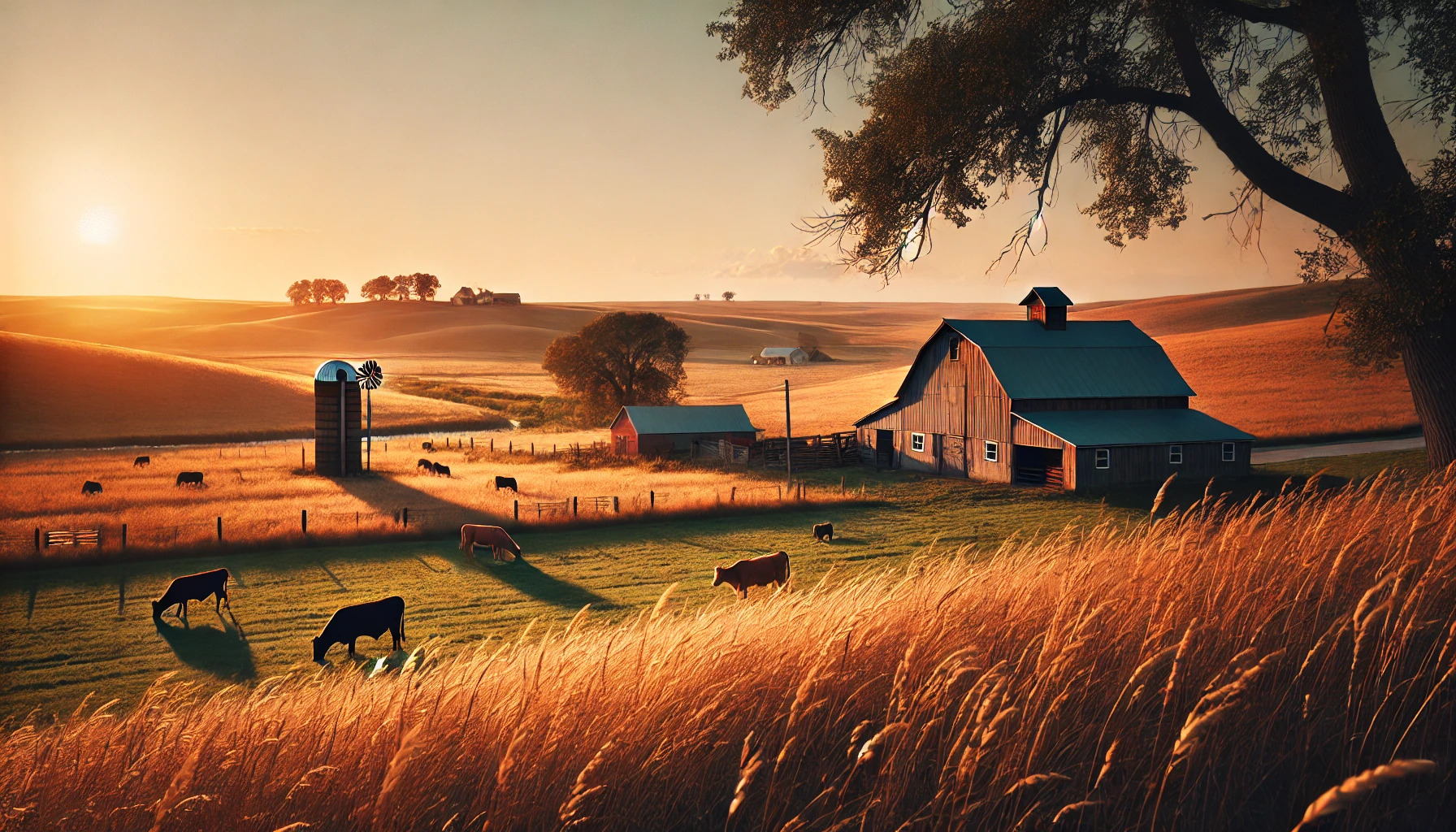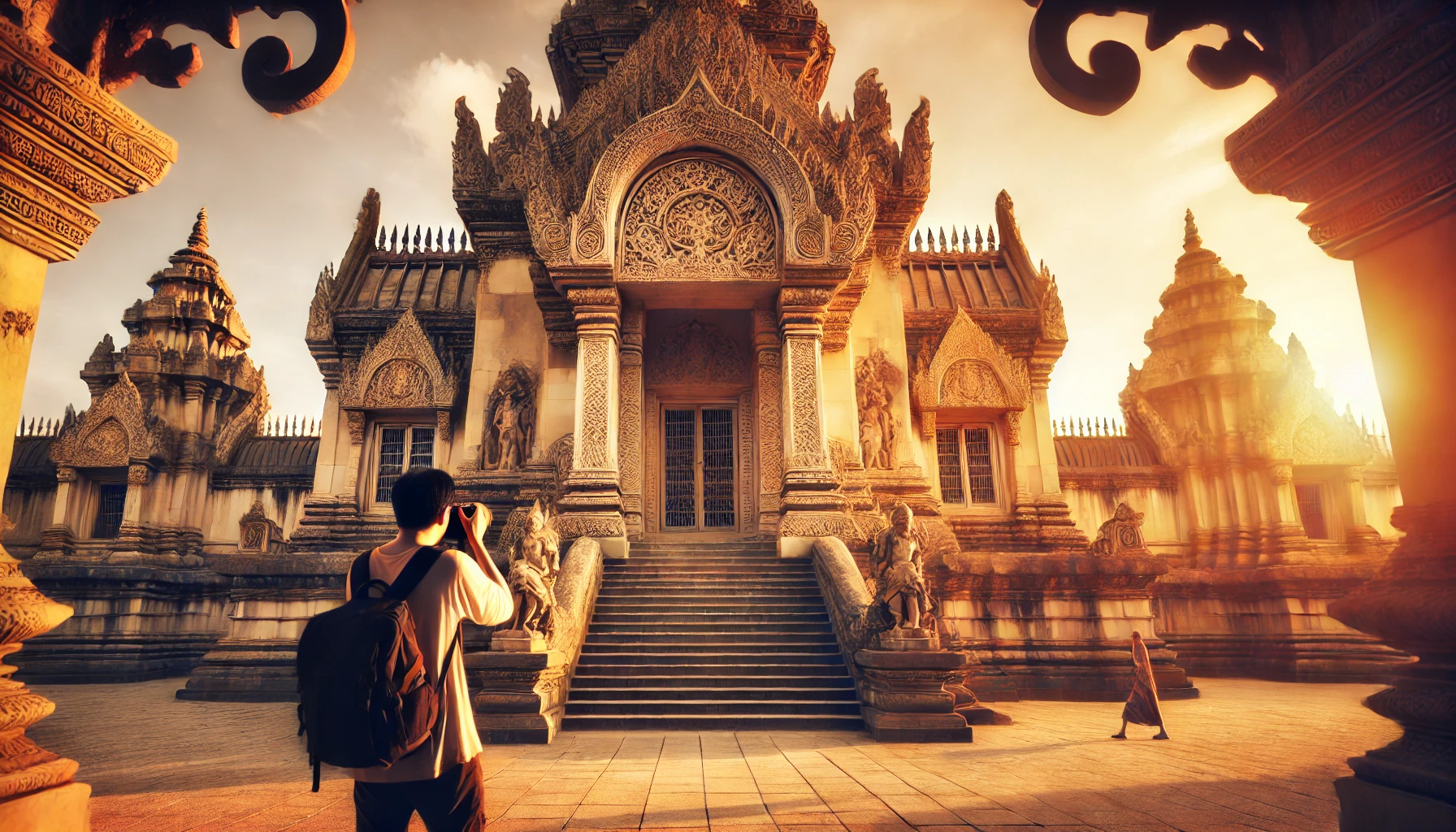The Central-West Region of Brazil is a true paradise for nature lovers, especially for those seeking breathtaking and unique landscapes to capture with their cameras. If you are a fan of photography and adventure, you cannot miss the incredible waterfalls in this region. Three must-visit destinations for capturing the essence of natural beauty are Cachoeira do Abismo, Catarata dos Couros, and Complexo do Macaquinho.
Cachoeira do Abismo
Located in the municipality of Cavalcante, Goiás, Cachoeira do Abismo is a spectacle in itself. With a waterfall about 100 meters high, it impresses with its grandeur and the force of the water crashing into a natural pool. Accessing this wonder requires a hike and some climbing, making the experience even more thrilling for adventurers.
From a photographic standpoint, Cachoeira do Abismo is a perfect subject. The way the water flows down the rock, combined with the contrast between the lush vegetation and the crystal-clear water, creates stunning images. The surrounding flora also offers a unique opportunity to capture moments of interaction between nature and the pristine waters.
Catarata dos Couros
If you’re a fan of dramatic and wild landscapes, Catarata dos Couros, located in the Chapada dos Veadeiros National Park, is the perfect choice. This group of waterfalls spread over a vast area offers one of the most photogenic scenes in the region. The water, originating from the Rio dos Couros, forms several interconnected cascades, creating a unique visual dance.
In addition to the waterfalls, the area around Catarata dos Couros is filled with large rocks, lush vegetation, and natural viewpoints, ideal for capturing different perspectives. Be sure to capture the golden hues the setting sun reflects on the water in the late afternoon, creating unforgettable images.
Complexo do Macaquinho
Located in the municipality of Alto Paraíso de Goiás, the Complexo do Macaquinho is a true paradise for photographers seeking crystal-clear waterfalls amidst preserved nature. The complex consists of several waterfalls that form small natural pools, with water in a turquoise hue that seems to come straight out of a dream.
With easy access, Complexo do Macaquinho is perfect for those who wish to capture the beauty of the cascades, as well as explore the region’s flora and fauna. The trails leading to the waterfalls allow photographers to choose different angles and perspectives, from close-ups of the moving water to wide shots that include the grandeur of the surrounding landscape.
Photography Tips for Waterfalls
To make the most of your photographic adventures at waterfalls in the Central-West region, here are a few tips:
- Use a tripod and manual settings: When photographing waterfalls, it’s crucial to use a tripod to ensure camera stability and avoid blurry photos. Adjust the shutter speed to capture the movement of the water, creating the smooth effect of the cascades.
- Shoot at dawn or dusk: The soft light at dawn or dusk provides a unique atmosphere for your photos. The golden light and warm hues of the sky can enhance the beauty of the waterfalls.
- Explore different angles: Don’t limit yourself to straight-on shots. Explore the trails, climb rocks, or get close to the edges to capture various perspectives of the waterfalls.
- Take advantage of reflections: The natural pools formed by the waterfalls can reflect the landscape, creating stunning visual compositions. Pay attention to the details and seize these moments.
Conclusion
The Central-West Region of Brazil, with its breathtaking waterfalls like Cachoeira do Abismo, Catarata dos Couros, and Complexo do Macaquinho, offers countless opportunities for photographers looking to capture the raw and untouched beauty of Brazil. These landscapes, with their imposing waterfalls, lush vegetation, and crystal-clear waters, are an invitation to explore nature and create images that tell stories of a deep and unforgettable Brazil.
If you’re planning your next photography trip, make sure to include these waterfalls on your itinerary. Prepare your camera, put your adventurous spirit to the test, and capture these awe-inspiring natural wonders!
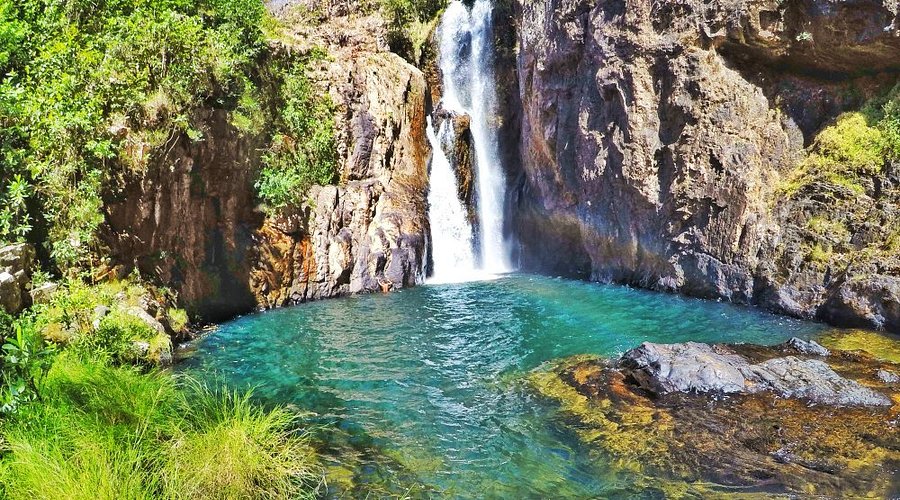
Discovering the Underground Wonders: Gruta do Lago Azul, Gruta do Mimoso, Gruta Catedral, and Gruta de São Miguel
The caves and grottos of Brazil are true natural treasures, offering stunning landscapes for photographers looking to capture the essence of subterranean beauty. The Central-West Region of Brazil, in particular, is home to some of the country’s most breathtaking caves. In this article, we will explore four of these wonders: Gruta do Lago Azul, Gruta do Mimoso, Gruta Catedral, and Gruta de São Miguel. Each of these offers a unique experience for adventurers and, of course, for photographers looking for unusual and fascinating settings.
Gruta do Lago Azul
Located in Bonito, in the state of Mato Grosso do Sul, Gruta do Lago Azul is one of Brazil’s most iconic caves. Its main attraction is the crystal-clear lake, which reflects a deep and vibrant blue tone, creating a stunning contrast with the cave’s limestone formations. The natural light that enters the cave, especially during the morning, creates a magical and surreal atmosphere, ideal for capturing incredible images.
For photographers, Gruta do Lago Azul offers the opportunity to play with light and shadow. The cave’s entrance and the natural light illuminating the lake provide unique photographic compositions. Additionally, the blue water and rock formations create a fascinating contrast, making every photograph a masterpiece.
Gruta do Mimoso
Gruta do Mimoso, located in Jardim, also in Mato Grosso do Sul, is a lesser-known yet equally impressive destination. With a narrow entrance, the cave reveals an interior full of stalactites and stalagmites, as well as beautiful speleothems (rock formations). The highlight of Gruta do Mimoso is the variety of shapes that the stalactites and stalagmites take on, creating exotic forms and sublime landscapes.
For photographers, this cave is an excellent opportunity to explore textures and details. The natural light entering through the entrance of the cave creates dramatic shadows, emphasizing the shapes and figures formed by the rock formations. Gruta do Mimoso is ideal for those looking to capture the beauty of subterranean natural structures and the contrasts between light and shadow.
Gruta Catedral
Gruta Catedral, located in Alto Paraíso de Goiás, in the Chapada dos Veadeiros, is one of the most imposing caves in the region. The name “Catedral” (Cathedral) comes from its enormous arch-shaped entrance, which resembles the architecture of a grand cathedral. The interior of the cave is vast, with several rock formations that create a grand and almost mystical environment. The light that enters through the opening of the cave creates a play of shadows and reflects off the rocks, creating impressive images.
Photographically, Gruta Catedral is a true cathedral of opportunities. The arch-shaped entrance, the rock formations, and the natural light entering through the opening allow the photographer to capture images that evoke a sense of mystery and grandeur. Angles can be explored in various ways to highlight both the grandeur of the cave and the small details of the rock formations.
Gruta de São Miguel
Gruta de São Miguel, located in São Gabriel do Oeste, in the state of Mato Grosso do Sul, is another subterranean wonder that attracts photographers seeking breathtaking landscapes. With its unique geological formation, the cave has a wide entrance and a series of passages that lead to inner chambers filled with various stalactites and stalagmites.
Photographing Gruta de São Miguel offers a diverse experience, as its various passages and internal chambers provide different perspectives and opportunities to capture the underground beauty. The contrast between the more illuminated areas and the darker ones creates a perfect play of light and shadows, ideal for capturing details and nuances of the local geology.
Tips for Photographing Caves and Grottos
Photographing caves and grottos requires some special techniques, as the lighting and underground environment can present challenges. Here are some tips to ensure you capture the best of each cave:
- Use a tripod: The low-light conditions in caves require long exposures to capture the soft light. A tripod is essential to avoid blurry photos and ensure sharp images.
- Explore natural light: Whenever possible, take advantage of the natural light entering through the openings of the caves. This light can create dramatic effects and highlight the rock formations.
- Adjust the ISO: In low-light environments, adjusting the ISO may be necessary to avoid overly dark images, but be careful not to overdo it, as this can introduce noise in the photos.
- Photograph textures and details: The rock formations inside the caves are full of interesting textures and unique patterns. Explore these details to capture fascinating images full of nuance.
- Use wide-angle lenses: To capture the grandeur of the caves, a wide-angle lens can be very helpful, allowing you to include the entire cave in your shots and emphasize the vastness of the environment.
Conclusion
Brazil’s caves, such as Gruta do Lago Azul, Gruta do Mimoso, Gruta Catedral, and Gruta de São Miguel, offer a variety of incredible settings for photographers looking to explore the underground world. Each of these caves has its unique features, from crystal-clear waters to imposing rock formations, creating unforgettable opportunities to capture breathtaking images. Prepare your camera, explore these fascinating environments, and capture the hidden beauty beneath the surface!
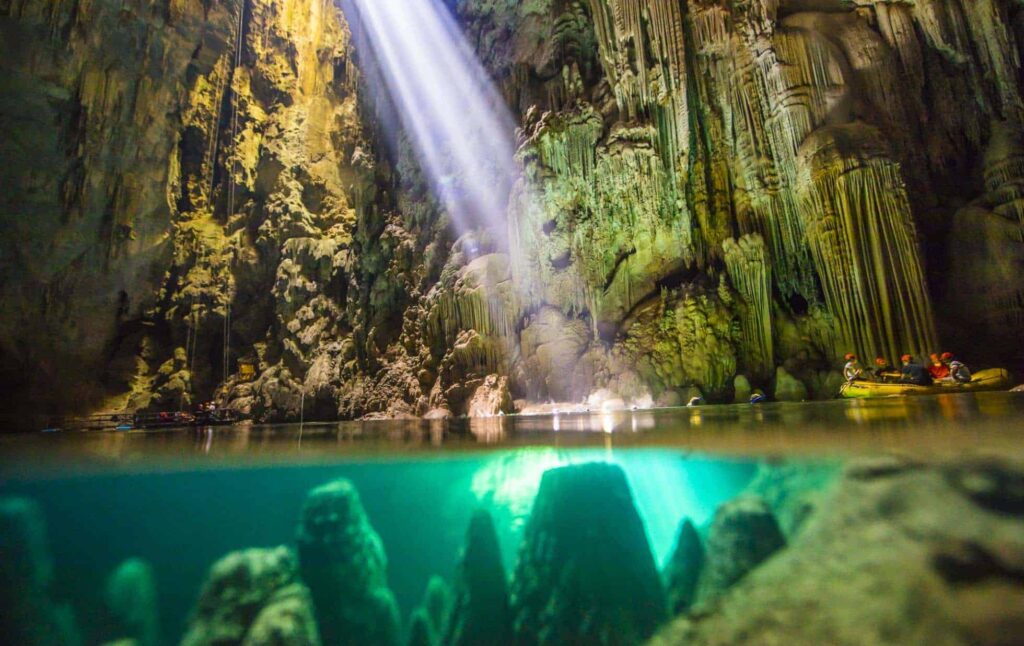
Exploring the Chapadas: Veadeiros and Guimarães – Paradises for Photographers
The Brazilian Midwest holds some of the country’s most stunning natural destinations, and the Chapadas dos Veadeiros (Goiás) and Chapadas dos Guimarães (Mato Grosso) are living proof of this. If you’re a photographer looking to capture majestic landscapes, unique rock formations, and breathtaking waterfalls, these two locations are undoubtedly must-visits.
Chapada dos Veadeiros, Goiás: Nature in Its Rawest Form
Located in the northwest of Goiás, Chapada dos Veadeiros is a true paradise for photographers. Its landscapes are like living paintings, with rock formations that seem to have been sculpted by nature itself. The region is famous for its lush biodiversity and its imposing waterfalls.
Main Photographic Attractions
- Chapada dos Veadeiros National Park: This park is the heart of the region, with trails leading to waterfalls like Almécegas and Loquinhas. The crystal-clear waters of the waterfalls become the highlight in photos, reflecting the wild beauty of the Cerrado.
- Cavalcante and the Kalunga Community: Known for its rich culture and the Santa Bárbara Waterfall, with turquoise waters, this is one of the most photographed landscapes in the Chapada. The combination of vibrant green and the sparkle of the water creates spectacular images, full of energy and beauty.
Chapada dos Guimarães, Mato Grosso: Where Stone Meets the Sky
Chapada dos Guimarães, located about 56 km from Cuiabá, is famous for its massive sandstone rock formations and its waterfalls descending from towering cliffs. The region, part of the Chapada dos Guimarães National Park, offers a diversity of landscapes that captivate any photographer.
Main Photographic Attractions
- Chapada dos Guimarães National Park: One of the region’s biggest landmarks, the Véu de Noiva Waterfall, with its 86-meter drop, is a sight to behold. The park offers trails revealing breathtaking panoramic views, with sandstone cliffs that seem to float over the horizon.
- Cidade de Pedra (City of Stone): This rock formation, resembling an ancient city in ruins, is a truly cinematic setting. Its sandstone structures and the plateau horizon create a mysterious and fantastic environment for creative shots.
Tips for Photographers
- Best Time to Visit: The best time to visit the Chapadas is during the dry season, from May to September, when the waterfalls are at their most beautiful and the trails are easier to walk. During the rainy season, waterfalls may become intense, making some trails more difficult to access.
- Ideal Equipment: Prepare for weather changes. Bring light clothing, sunscreen, and insect repellent, but also keep a jacket handy for cooler periods, especially if visiting Chapada dos Veadeiros during the winter. A good camera with versatile lenses is essential to capture both vast landscapes and the small details of the local fauna and flora.
- Respect the Environment: Both parks require visitors to follow preservation rules. Make sure not to leave any trash behind and respect local communities, ensuring that future generations can also marvel at these stunning landscapes.
Conclusion
Both Chapada dos Veadeiros and Chapada dos Guimarães offer an immense variety of natural landscapes that, in addition to being breathtaking, provide incredible opportunities for any photographer. Each corner of these regions holds a story, texture, and color that deserve to be captured. If you’re looking for photographs that capture the grandeur of Brazilian nature, these two destinations are true paradises waiting for you.
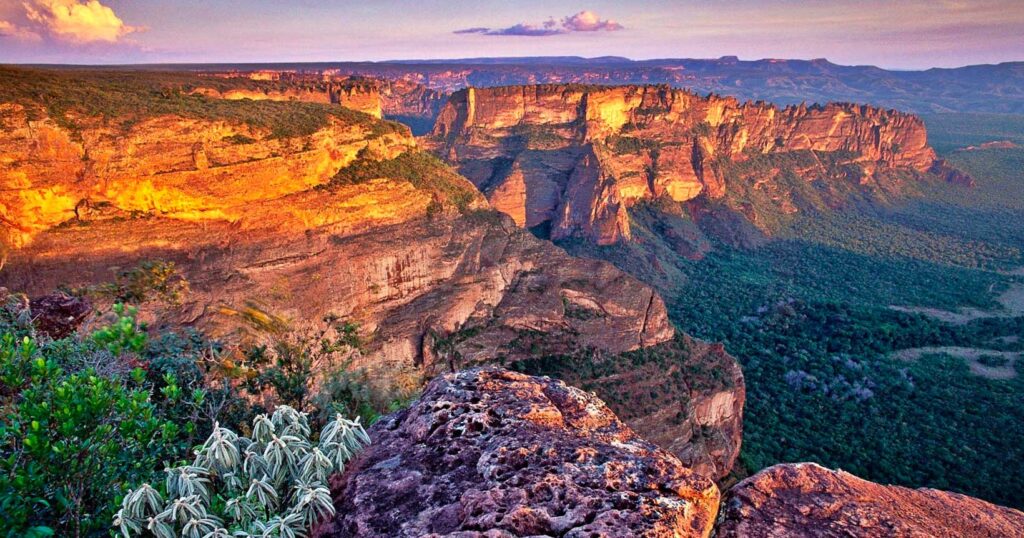
Pantanal de Cáceres: A Photographic Haven on the Border with Bolivia
The Pantanal de Cáceres, located in the state of Mato Grosso, Brazil, is one of the richest and most fascinating ecosystems on the planet. With its vast flooded plains extending to the border with Bolivia, the Pantanal offers one of the most extraordinary photographic experiences for those looking to capture wildlife, natural beauty, and the immensity of Central Brazil.
This natural paradise, in addition to being a hotspot of incredible biodiversity, is the perfect destination for photographers looking to record magical and unique moments in a grand and relatively unexplored setting.
Pantanal de Cáceres: A Hidden Gem
Cáceres, a city strategically located in the Pantanal region, serves as the gateway for anyone looking to explore this immense territory of untamed nature. This destination is renowned for its breathtaking landscapes and rich fauna, with highlights including species such as jaguars, caimans, capybaras, and a wide variety of exotic birds.
Main Photographic Attractions in Pantanal de Cáceres
- The Meeting of Waters: The Pantanal is one of the largest inland water systems in the world, with rivers, lagoons, and channels interwoven in a visually stunning spectacle. The convergence of waters, especially at the start of the rainy season, offers photographers an excellent opportunity to capture perfect reflections and the transition from land to water.
- Wildlife: The biodiversity of Pantanal de Cáceres is unmatched. With numerous parks and nature reserves nearby, the region is ideal for photographing wildlife in its natural habitat. Jaguars, for example, are one of the main attractions. Capturing moments of hunting, animal interactions, and even rare bird species, like the tuiuiú (symbol of the Pantanal), are common scenes that captivate photographers.
- Pantanal Sunset: The sunset in Pantanal de Cáceres is considered one of the most beautiful in Brazil. As the sun sets, the sky transforms into a palette of colors ranging from oranges and reds to golds, creating the perfect backdrop for stunning photographs. The reflection of the light on the water and the presence of animals on the horizon make this one of the best photographic opportunities in the region.
Tips for Photographers in Pantanal de Cáceres
- Ideal Equipment: The Pantanal is a region with great diversity of fauna and flora, so it’s important to have a camera with good zoom capabilities, especially for capturing animals in motion. Long-range lenses, such as 200mm or 300mm, are essential for wildlife shots at a distance. Additionally, a sturdy tripod for long exposure shots and a polarizing filter to avoid unwanted reflections can be very helpful. Protection against moisture and dust should also be considered due to the humid environment and the large amounts of mud in the region.
- Best Time to Visit: The best time to photograph Pantanal de Cáceres is during the dry season, from May to September, when animals tend to concentrate around water sources. The rainy season, from October to April, brings spectacular landscapes but may make access to certain areas more difficult. Photographers should be prepared for logistical challenges during this period, but the visual impact of the rain on the landscapes makes it worth the effort.
- Respect the Environment: When photographing in Pantanal de Cáceres, it’s essential to follow sustainable tourism practices. Avoid getting too close to animals, respect the trails, and ensure that no waste is left behind in the visitation areas—basic rules to preserve this unique ecosystem.
Conclusion
Pantanal de Cáceres, on the border with Bolivia, is a perfect destination for photographers who wish to capture wildlife and the unique beauty of one of the planet’s largest biomes. With its vastness, biodiversity, and breathtaking landscapes, it is an ideal location to explore and document nature in its purest and most impressive form. If you’re passionate about nature photography, Pantanal de Cáceres will undoubtedly become one of your favorite destinations.
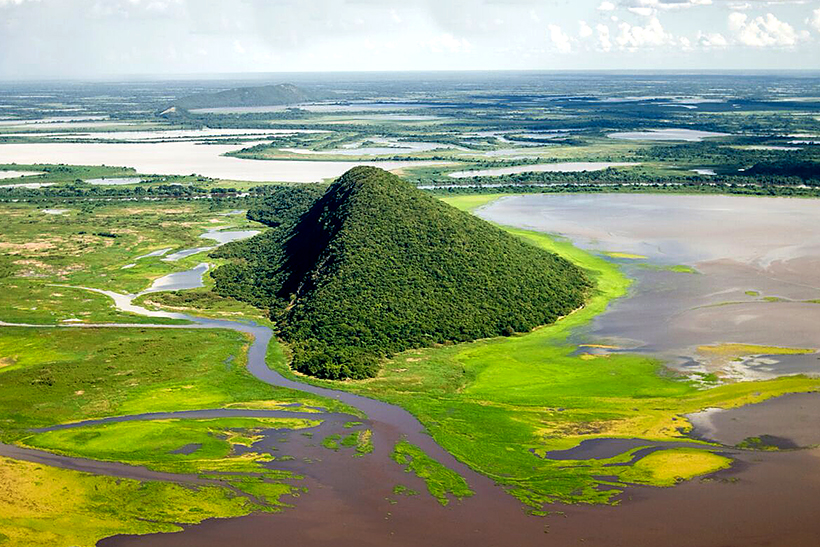
Vale da Lua and Its Charms: Exploring the Natural Beauty of Cáceres
Cáceres, located in the state of Mato Grosso, Brazil, is a fascinating destination offering a series of natural and cultural wonders. Among its breathtaking landscapes, the Vale da Lua (Moon Valley), with its unique lunar-like surface, stands out as a true geological spectacle. Alongside the impressive Dolina Água Milagrosa, the historic Marco de Jauru, and the imposing Catedral de São Luiz, the region promises an enriching experience for both photography lovers and those seeking to explore the local nature and culture.
Vale da Lua: A Lunar Landscape in the Heart of Brazil
Located in Chapada dos Guimarães, just a few kilometers from Cáceres, Vale da Lua is one of the most stunning destinations in Brazil. Its rocky surface, shaped by water over millennia, features formations that resemble the moon, with natural pools and “caves” formed by erosion. The result is a surreal, almost extraterrestrial landscape that attracts tourists and photographers seeking unique images and a connection to the primal nature of our planet.
Photography in Vale da Lua
For photographers, Vale da Lua offers a unique opportunity to capture textures and geometric shapes. The soft lighting at sunset creates spectacular contrasts between the rocks and the sky, providing a magical atmosphere for your shots. Additionally, the natural pools of water reflect the rocks and the sky, creating the perfect setting for unforgettable photographs.
Dolina Água Milagrosa: A Crystal-clear Lagoon in an Imposing Cave
Dolina Água Milagrosa, located in a 200-meter-high cave, is another natural spectacle found near Cáceres. The crystal-clear lagoon at the bottom of the cave has a charming blue hue, and the enormous entrance, with its stone walls and stalactites, provides an imposing and mysterious backdrop.
Photography at Dolina Água Milagrosa
For those looking to capture the essence of this magical place, the light that filters through the entrance of the cave is essential. During certain times of the day, natural lighting creates stunning effects on the crystal-clear water, reflecting the interior of the cave and the rock formations. A wide-angle lens is ideal for capturing the grandeur of the cave and lagoon, while using a polarizing filter can help bring out the vibrant colors of the water.
Marco de Jauru: A Historic Landmark in Cáceres
The Marco de Jauru, located in the Cáceres region, is one of the most important historical landmarks of the city. It marks the border between the states of Mato Grosso and Bolivia, and holds great cultural and symbolic value for the local people. Although simple, the monument is an excellent spot for historical photography, where you can capture both the essence of Brazil’s border history and the grandeur of the surrounding landscape.
Photography at Marco de Jauru
When photographing Marco de Jauru, it’s interesting to capture both the monument and the surrounding landscape, which blends Cerrado vegetation with the vast horizon. The sunset can be a perfect opportunity to capture the golden light bathing the monument, creating an image that reflects both the historical and natural beauty of the region.
Catedral de São Luiz: The Architectural Beauty of Cáceres
The Catedral de São Luiz, located in downtown Cáceres, is one of the city’s architectural landmarks and an important religious symbol. With its imposing construction and classic style, the cathedral is an ideal location for photography enthusiasts seeking to capture the grandeur of historic buildings.
Photography at Catedral de São Luiz
The cathedral, with its tall towers and architectural details, offers numerous opportunities for photos from various angles. During the day, natural light illuminates the facade, highlighting the details of the building, while at night, the exterior lights create a dramatic effect, perfect for capturing the beauty of the site after dark.
Conclusion: The Magic of Cáceres and Its Charms
Cáceres is a destination that perfectly combines natural beauty with rich historical and cultural heritage. From the surreal formations of Vale da Lua to the historical grandeur of Marco de Jauru and Catedral de São Luiz, the city offers photographers and adventurers landscapes that are both challenging and enchanting. The Dolina Água Milagrosa and its underwater mysteries complete the experience, making Cáceres an unmissable destination for anyone seeking to capture the heart of Brazil.



